The best Halloween garden I spotted on the way into work. This was at the White House pub on Abingdon Road.
Tuesday, 31 October 2017
Happy Halloween!
The best Halloween garden I spotted on the way into work. This was at the White House pub on Abingdon Road.
Sunday, 29 October 2017
Alexandra Palace Lily Pond
It was my first time at Ally Pally. Tim remembered it from gigs from when he used to live in London. I was boggling at the high Victoriana, the ironwork, the trees. Then I found the little formal garden with the lily pond, still showing lillies, even in September.
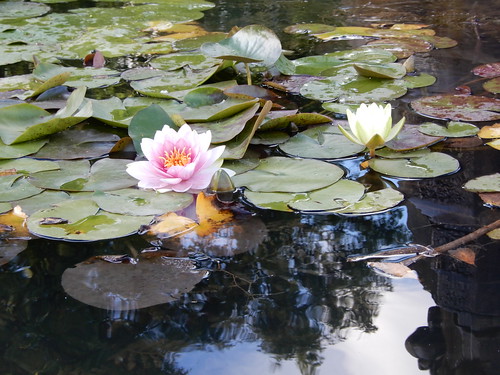

We were seeing LCD Soundsystem. I didn't have any time to take photos inside, even though there's a winter garden and a food hall and all sorts. Being inside your palace seeing the best of bands is kind of all-consuming.


We were seeing LCD Soundsystem. I didn't have any time to take photos inside, even though there's a winter garden and a food hall and all sorts. Being inside your palace seeing the best of bands is kind of all-consuming.
Wednesday, 25 October 2017
considering a series of unwise purchases
While I'm waiting for my replacement Garden Club Card to turn up I've held off heading down the road to the garden centre. That hasn't stopped me considering (though not yet giving into) some unwise purchases:
A Stepover Greengage Tree. This purchase, so unwise it is bordering on the absurd, would further dessicate the deep bed and probably produce a sad and sickly tree. I do like greengages, though. They are my favourite of all stone fruits. A pollenator partner is indicated, too, so I can't get just one. Who could resist an Opal? Hmf. Maybe after I've had the overhang cut back.
More Tulip Bulbs. The Crocus Sale is on. Don't they look fabulous? I do have a great many tulips already. Not everything is perennial, of course, but mostly I have enough in there to come up year on year. Tulips. Tulips. The first frost has come, but the air is still warm. It's the perfect time to plant.
Ever since I saw that mainstay of my childhood playgrounds, decorative glass chippings, at Gardener's World Live, I can't get them out of my head. I could use them to top a pot, couldn't I? They wouldn't stay lovely for long, but it would make a significant change from my regular stone-mulch of pebbles and gravel, and nice inactive glass won't bring the problems like my granite and limestone chips do (must just get rid of those). Oooh those decorative aggregates. So many colours!
A Chinese Money Plant is currently buzzing around my head as the latest indoor plant purchase. It is true, now, that I need some trailing greenery around a newly excavated indoor window, but I already have a lot of plants. There's a Mandevilla in waiting. If the Rickrack Cactus takes (I currently have a sulking, but not dead, cutting) there's that too. But now that I've seen one in real life (at Modern Art Oxford cafe no less) I want one even more.
Time to step back and consider awhile. And maybe actually do the big things (the cutback, the fern wall) first?
A Stepover Greengage Tree. This purchase, so unwise it is bordering on the absurd, would further dessicate the deep bed and probably produce a sad and sickly tree. I do like greengages, though. They are my favourite of all stone fruits. A pollenator partner is indicated, too, so I can't get just one. Who could resist an Opal? Hmf. Maybe after I've had the overhang cut back.
More Tulip Bulbs. The Crocus Sale is on. Don't they look fabulous? I do have a great many tulips already. Not everything is perennial, of course, but mostly I have enough in there to come up year on year. Tulips. Tulips. The first frost has come, but the air is still warm. It's the perfect time to plant.
Ever since I saw that mainstay of my childhood playgrounds, decorative glass chippings, at Gardener's World Live, I can't get them out of my head. I could use them to top a pot, couldn't I? They wouldn't stay lovely for long, but it would make a significant change from my regular stone-mulch of pebbles and gravel, and nice inactive glass won't bring the problems like my granite and limestone chips do (must just get rid of those). Oooh those decorative aggregates. So many colours!
A Chinese Money Plant is currently buzzing around my head as the latest indoor plant purchase. It is true, now, that I need some trailing greenery around a newly excavated indoor window, but I already have a lot of plants. There's a Mandevilla in waiting. If the Rickrack Cactus takes (I currently have a sulking, but not dead, cutting) there's that too. But now that I've seen one in real life (at Modern Art Oxford cafe no less) I want one even more.
Time to step back and consider awhile. And maybe actually do the big things (the cutback, the fern wall) first?
Sunday, 22 October 2017
chaos enough gardening
When I was growing up, my favourite garden was attached to an abandoned cottage. In the way of the country, most of the cottage had been recycled; the stones had gone to reinforce gateways or build outhouses at the local farms, the timbers had gone to firewood, and anything reusable had been reused. All that remained of the house were the lumps, dips and levels; chunks of stone too heavy to move, now grassed and mossed over, flats and spaces marking hearth, floor, pantry.
The garden, however, was still an active force. The hedge had grown up and out, nibbled by sheep and hedgetrimmers into open, perforated lines of bushes, easy enough for a child to slip between. Inside the sheltered hedgebound space, the wind dropped and the sun intensified. In the warm space within the remnants of old garden flowers tangled with the wild; Goldenrod, Perennial Sunflower and Michaelmas Daisies held their own against the Stitchwort and Campions; wild roses and tame arced through the high hedges. A star of clematis, a spark of Jasmine.
The grass was meadow-thick, a deep and forgiving coverlet that hung slightly above the ground below, and gave as you stood on it, just a little bit. Each spring, a sprinkling of bulbs would stipple the banks; snowdrop, daffodil, grape hyacinth. You had to watch your step, as under the grass would be shattered, slippery wall stones, unexpected and bruising.
There was a quietness in the space; nothing spooky, but the usual noises of the downs (the cows, the wind, the farmnoise, the ocassional passing car) would shrink, and the birdsong would become more audible although no louder. Nothing spooky, just a dying fall, a slow diminuendo as the tame sank back into the wild.
The tumble-down garden returning to the wild; the bright flashes of resilience against the returning natives; that perfect moment in the entropic slide back to the Darwinian tangled bank when your garden is just chaos enough; that is what I am aiming for.
The garden, however, was still an active force. The hedge had grown up and out, nibbled by sheep and hedgetrimmers into open, perforated lines of bushes, easy enough for a child to slip between. Inside the sheltered hedgebound space, the wind dropped and the sun intensified. In the warm space within the remnants of old garden flowers tangled with the wild; Goldenrod, Perennial Sunflower and Michaelmas Daisies held their own against the Stitchwort and Campions; wild roses and tame arced through the high hedges. A star of clematis, a spark of Jasmine.
The grass was meadow-thick, a deep and forgiving coverlet that hung slightly above the ground below, and gave as you stood on it, just a little bit. Each spring, a sprinkling of bulbs would stipple the banks; snowdrop, daffodil, grape hyacinth. You had to watch your step, as under the grass would be shattered, slippery wall stones, unexpected and bruising.
There was a quietness in the space; nothing spooky, but the usual noises of the downs (the cows, the wind, the farmnoise, the ocassional passing car) would shrink, and the birdsong would become more audible although no louder. Nothing spooky, just a dying fall, a slow diminuendo as the tame sank back into the wild.
The tumble-down garden returning to the wild; the bright flashes of resilience against the returning natives; that perfect moment in the entropic slide back to the Darwinian tangled bank when your garden is just chaos enough; that is what I am aiming for.
Wednesday, 18 October 2017
the ivied walls of the last days of summer
The weather snapped cold, all of a sudden yesterday. I was dashing into work and some quirk of the atmosphere had brought down air cold enough that I saw my breath, clouds in the air for the first time this year. The cold has been late coming this year, and accordingly the land has borne fruit. I have grapes this year, raspberries, even a few sad apples on my ailing apple tree.

The warmth has also caused a green seep to rise up across the walls, and strike out into the gardens and up the trees; bindweed, nasturtium, passion vine, virginia creeper and the endless, unstoppable, steady creep of ivy, at this time of year buzzing with bees drunk on its autumn flowers. Don't cut me back, it says, exhaling out another three feet of cabled, clinging growth, not quite yet. Leave me for the bees and brightness and the flowers which smell like your grandmother's handcream.
It's being disingenuous. Unlike the Nasturtium I see my neighbour lifting up like a rug to mow underneath, or the bindweed whose white flowers I have come to love in this chaotic year, it won't melt to slime at the first hard frost. Ivy is eternal; the only limiter on the ivy I have as a lightener on my shadiest wall is me.
But even so, if it makes it to November, I'll probably leave it.

The warmth has also caused a green seep to rise up across the walls, and strike out into the gardens and up the trees; bindweed, nasturtium, passion vine, virginia creeper and the endless, unstoppable, steady creep of ivy, at this time of year buzzing with bees drunk on its autumn flowers. Don't cut me back, it says, exhaling out another three feet of cabled, clinging growth, not quite yet. Leave me for the bees and brightness and the flowers which smell like your grandmother's handcream.
It's being disingenuous. Unlike the Nasturtium I see my neighbour lifting up like a rug to mow underneath, or the bindweed whose white flowers I have come to love in this chaotic year, it won't melt to slime at the first hard frost. Ivy is eternal; the only limiter on the ivy I have as a lightener on my shadiest wall is me.
But even so, if it makes it to November, I'll probably leave it.
Labels:
autumn,
climbers,
cold weather,
ivy,
overcrowding
Sunday, 15 October 2017
the promised rose garden
Just outside Oxford's Botanic Garden is an curiously designed permanently public garden, bounded by hedges and right by the main road into Oxford City Centre. At one end, a sinister tunnel of copper beeches throw a gravel walk into deep shade. At the other end is the entry to the gardens. Inbetween there is a stretch of box-hedge maze containing flower beds, growing roses. Lots of roses.









It's curiously retro space; gravel crunches underfoot, and the soil between the roses is weeded bare, in the old style. The smell of the box and the smell of the roses combines into a grandmotherly pleasantness, undercut by the tang of traffic fumes from the main road. Almost every month of the year, some roses are in flower. I've walked this maze in the snow, and knocked snow off fresh blossoms. The English Rose is resilient as well as ravishing.
At this time of year, the breath of autumn is on the flowers. Blooms are fading, wreathed in spider's webs, outer petals spotted by rain and the end of summer. The petals are streaked and stained like antique silks, and here and there sunk into rot, a cludgy mass of brown petals clinging damply to the growing rosehip.
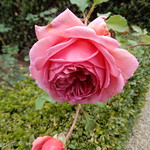

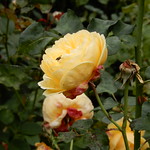
I am rather too fond of roses. I own too many for my tiny garden, and they're all the wrong varieties. I'm growing a shrub rose up a fence; tiny florists' roses have been set free from their decorative troughettes and left to ramble madly through the flower beds. Some grand prestige tea roses in fancy colours are roughing it among the alkanets and hellebores in the deep shade. One of them turned out to have variegated leaves, in shattered green shades; that one's buried in the dark under an overhang.
But still, year on year, they remain, defiantly my roses.









It's curiously retro space; gravel crunches underfoot, and the soil between the roses is weeded bare, in the old style. The smell of the box and the smell of the roses combines into a grandmotherly pleasantness, undercut by the tang of traffic fumes from the main road. Almost every month of the year, some roses are in flower. I've walked this maze in the snow, and knocked snow off fresh blossoms. The English Rose is resilient as well as ravishing.
At this time of year, the breath of autumn is on the flowers. Blooms are fading, wreathed in spider's webs, outer petals spotted by rain and the end of summer. The petals are streaked and stained like antique silks, and here and there sunk into rot, a cludgy mass of brown petals clinging damply to the growing rosehip.



I am rather too fond of roses. I own too many for my tiny garden, and they're all the wrong varieties. I'm growing a shrub rose up a fence; tiny florists' roses have been set free from their decorative troughettes and left to ramble madly through the flower beds. Some grand prestige tea roses in fancy colours are roughing it among the alkanets and hellebores in the deep shade. One of them turned out to have variegated leaves, in shattered green shades; that one's buried in the dark under an overhang.
But still, year on year, they remain, defiantly my roses.
Wednesday, 11 October 2017
kokedama in commercial space
I found this in a fancy shop window the other day and could not remember what these cutesy, hipsterish moss-bundles were called. Kokigami, my brain kept insisting, as I stumbled blunt-fingered over my Instagram post, Kokigami. No, Kokigame, is not the right word, thank-you brain. Sheesh.
I think you mean Kokedama.
There's obviously been a bit of dribble from the balls. As it were. They are a pretty thing, there's no denying it. Elaborate instructions suggest that the items are quite obtainable in a domestic context, too. But I think that a drip tray will be needed.
My kitchen's being done at the moment, and when it's completed I'll have a long sequence of carefully washing plaster dust off all my plants, and then I'll have a new place to put plants, as I'll need some to trail across an internal window.
I'm fancying a Chinese Money Plant. But maybe I could break it up with a kokedama, here and there.
I think you mean Kokedama.
There's obviously been a bit of dribble from the balls. As it were. They are a pretty thing, there's no denying it. Elaborate instructions suggest that the items are quite obtainable in a domestic context, too. But I think that a drip tray will be needed.
My kitchen's being done at the moment, and when it's completed I'll have a long sequence of carefully washing plaster dust off all my plants, and then I'll have a new place to put plants, as I'll need some to trail across an internal window.
I'm fancying a Chinese Money Plant. But maybe I could break it up with a kokedama, here and there.
Sunday, 8 October 2017
waldspirale and the afforestation of the terraces
I was reminded today of Hundertwasser's concept of window-rights, whereby every resident should be able to alter the appearance of windows, and line the eyes of their house with colour and tiles and whatever else seems to work, up to the length their arm can reach. I'm charmed as ever by the irresistibly glam idea of giving your windows a Barry M blast, but even moire delighted to find it ballasted by the idea of tree-tenants and greened terraced roofing which returns 100% - or, ideally, a little more - of the land taken by the housing to nature, architecture in balance with vegitecture.
Tree Tenants grow from inside the building. Dedicated small rooms contain a large stainless steel tub, which hold a small tree that lunges out of the building and up into the light. Although the picture below is more a conceptual image than the practical details of waterproof membranes and steel supports which create a successful tree tenant, the principles are clear; the tree tenant is watered via rainwater collection, with supplementary water and fertilising provided by the human tenants, as part of their tree duty (toileting pun intended).
The green terrace roofing concept is also shown above, but the details about the terraces is revealing:
But it is the idea of thirds that I like the most. A third for yourself, a third for the public and a third for nature to claim. Let it green and let it grow, and look after your tree tenants, for they are also looking after you.
Tree Tenants grow from inside the building. Dedicated small rooms contain a large stainless steel tub, which hold a small tree that lunges out of the building and up into the light. Although the picture below is more a conceptual image than the practical details of waterproof membranes and steel supports which create a successful tree tenant, the principles are clear; the tree tenant is watered via rainwater collection, with supplementary water and fertilising provided by the human tenants, as part of their tree duty (toileting pun intended).
The green terrace roofing concept is also shown above, but the details about the terraces is revealing:
Part of the terraces is publicly accessible, another part is private, and a third portion is reserved for spontaneous vegetation, i. e.; off limits, taboo for man. If one includes those portions of green surface lying beneath perpendiculars, more than 100 % of the ground plan is planted with greenery and trees. On the roof, nature was given back what the house had taken away from her. - Hundertwasser, 1985Green roofs constructed again and again in all of Hundertwasser's architecture. The Waldspirale (Forest Spiral) building has as many tree tenants as human tenants, and can be scaled as if it were a hill. Hundertwasser's opinion that vegetation should grow on all horizontal spaces in the city, on the roads and on the roofs, wherever rain falls or snow rests, is poetic and compelling in its determination and impracticality. Impracticality? It is a value-driven word. If trees and greenery are a priority, then they can be integrated. The innovations of Sepp Kratochwil can interweave trees and humans, put lakes on parks on the roof, and yes some maintenance is required, but is that not always the case?
But it is the idea of thirds that I like the most. A third for yourself, a third for the public and a third for nature to claim. Let it green and let it grow, and look after your tree tenants, for they are also looking after you.
Wednesday, 4 October 2017
Gardening in the rain
Gardening in the rain is a curious pleasure. There's the aggravating dampness of the soil of course, which never seems quite to be at the right consistency, always too sloppy, too muddy, or perversely dry under the run-off, on a hot summer day when the skies open. Planting in the rain is sometimes unavoidable; the only day you can put in a hedge, for example, or a plant that just won't wait. The rain beats down on your back as you bend over, seeping through the seams of the never-quite-waterproof coat. You stop yourself as you're heeling in the soil around the plant as it's too wet, and you'll compress the soil too far. Or you forget, and then have to relift it a little, trying not to tear any roots.

Cutting back in the rain is a soggy business. I'm not one of those that frets and panics about exposing my plants' cut stems or branches to wet, but the sense of resistance from the plant in wet weather is higher. All around the garden exhales, enlarges, audibly swells, and you with your secateurs aren't going to be able to make much of a dent. The plants playfully slap you in the face, dropping rain down your front and across your legs. Water soaks through on the chest and thighs, the tops of the arms, the shoulders; rain soaking the shelves of your body made as you lean back, crouch down, reach. The garden laughs in your face and sprays up fresh hoses of green, fired by the rain.

Weeding in the rain, though. The easiest weed of all. The soft soil gives up seedlings easily, and nothing can hide when it's questing for raindrops. You get muddy of course; muddy hands, muddy knees, wet ankles from crouching down among the plants. But out they come and into the compost, while all around, every plant in the garden is catching raindrops.


Cutting back in the rain is a soggy business. I'm not one of those that frets and panics about exposing my plants' cut stems or branches to wet, but the sense of resistance from the plant in wet weather is higher. All around the garden exhales, enlarges, audibly swells, and you with your secateurs aren't going to be able to make much of a dent. The plants playfully slap you in the face, dropping rain down your front and across your legs. Water soaks through on the chest and thighs, the tops of the arms, the shoulders; rain soaking the shelves of your body made as you lean back, crouch down, reach. The garden laughs in your face and sprays up fresh hoses of green, fired by the rain.

Weeding in the rain, though. The easiest weed of all. The soft soil gives up seedlings easily, and nothing can hide when it's questing for raindrops. You get muddy of course; muddy hands, muddy knees, wet ankles from crouching down among the plants. But out they come and into the compost, while all around, every plant in the garden is catching raindrops.

Sunday, 1 October 2017
bus-stop moss gardens
Taking a double decker bus into town lets you look down on the city. Not from a dizzy height; more from a giraffe-neck height. You get the megafauna view of the urban environment. And new vistas unfold, like these bus-stop roofgardens:
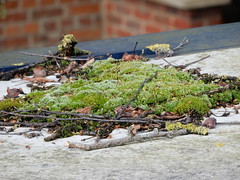

These are under mature trees and the amount of biomass falling from them is magnificent. Where the leaves brush the bus-stop, algae has grown in the green dimness, scraped by the bus-gusted leaves of the Plane trees.


Where the trees are cut higher, lichen has speckled the surface, and wherever there is enough debris or damage to form a small puddle, moss has grown. They say that moss will kill a surface; it's doubtless true. These two stops at the end and beginning of their cleaning and maintenance cycle remind that this is a temporary garden; here until cleared.

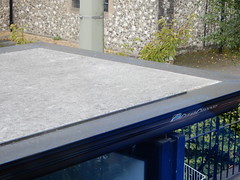
But below the bleakest of the busstops, there is still a halo of green murk and moss where the water drips down around the stop, and the moss and algae swept down onto the welcoming tarmac.


Urban surfaces moss over fast round here. A moment's pause in the damp, and the moss will rise and cover all in the soft, spongy, drenching cushions of the temperate waterworld.


These are under mature trees and the amount of biomass falling from them is magnificent. Where the leaves brush the bus-stop, algae has grown in the green dimness, scraped by the bus-gusted leaves of the Plane trees.


Where the trees are cut higher, lichen has speckled the surface, and wherever there is enough debris or damage to form a small puddle, moss has grown. They say that moss will kill a surface; it's doubtless true. These two stops at the end and beginning of their cleaning and maintenance cycle remind that this is a temporary garden; here until cleared.


But below the bleakest of the busstops, there is still a halo of green murk and moss where the water drips down around the stop, and the moss and algae swept down onto the welcoming tarmac.


Urban surfaces moss over fast round here. A moment's pause in the damp, and the moss will rise and cover all in the soft, spongy, drenching cushions of the temperate waterworld.
Subscribe to:
Posts (Atom)



